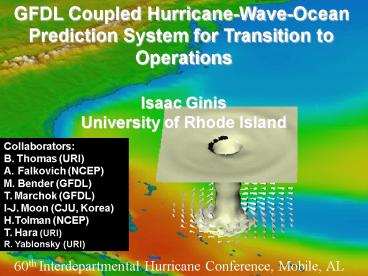GFDL Coupled HurricaneWaveOcean - PowerPoint PPT Presentation
1 / 19
Title:
GFDL Coupled HurricaneWaveOcean
Description:
Effect of Loop Current on SST Response in Hurricane Katrina. 2005 GFDL. Sea Surface Temperature ... Hurricane Katrina. Red Coupled Model, Green Uncoupled ... – PowerPoint PPT presentation
Number of Views:72
Avg rating:3.0/5.0
Title: GFDL Coupled HurricaneWaveOcean
1
GFDL Coupled Hurricane-Wave-Ocean Prediction
System for Transition to Operations Isaac
Ginis University of Rhode Island
- Collaborators
- B. Thomas (URI)
- Falkovich (NCEP)
- M. Bender (GFDL)
- T. Marchok (GFDL)
- I-J. Moon (CJU, Korea)
- H.Tolman (NCEP)
- T. Hara (URI)
- R. Yablonsky (URI)
60th Interdepartmental Hurricane Conference,
Mobile, AL
2
Air-Sea Interaction Upgrades for Possible
Implementation in 2006 GFDL Forecast System
- Ocean model initialization
- Loop Current and warm-core rings initialization
in the Gulf of Mexico - Air-sea momentum flux parameterization
- Coupled hurricane-wave-ocean system
3
Improved Ocean InitializationOcean climatology
data sets evaluated GDEM 0.5, GDEM 0.25,
LEVITUS 0.25Comparisons with AXBT profiles in
Hurricane Dennis (2005)
AXBTs in Front
AXBTs in Wake
AXBT data provided by Eric Uhlhorn, NOAA HRD
4
Improved Ocean Model Initialization GDEM 0.5
Ocean climatology provides better comparisons
with AXBTsComparisons with AXBT profiles in
Hurricane Dennis (2005)
AXBTs in Front
AXBTs in Wake
5
Hurricanes Katrina and Rita Perfect Storms ?
GDEM 0.5 temperature at 75 m depth with LC
NCEP SST Analysis
6
New Loop Current Initialization
2006 GFDL
2005 GFDL
Temperature 75 m depth
Temperature 75 m depth
7
Effect of Loop Current on Hurricane Katrina
Red LC 27.6oN, Green LC 24oN
Central Pressure
LC 24oN
Maximum Winds
LC 27.6oN
8
Effect of Loop Current on SST Response in
Hurricane Katrina
2005 GFDL
2006 GFDL
Sea Surface Temperature
Sea Surface Temperature
9
Effect of Ocean Coupling on Hurricane Katrina
Red Coupled Model, Green Uncoupled Model
(fixed SST)
Uncoupled Model
10
New Loop Current and Warm-Core Ring Initialization
Temperature 75 m depth
11
Improved Momentum Flux Parameterization
2005
2005
2006
2006
New roughness length and drag coefficient
parameterization are based on coupled wind-wave
simulations (CWW) in hurricanes using an
improved version of WAVEWATCH III
12
Improved Ocean Momentum Flux Parameterization
Momentum Flux from Atmosphere ( )
Horizontal Wave Propagation
Wave Growth
Atmosphere
Surface Waves
Ocean
Momentum Flux into the ocean ( )
Subsurface Currents
13
Surface Waves in Hurricanes Reduce Momentum Flux
Into Ocean by 10-15
Downward Momentum Flux Percentage
()
14
2005 GFDL
GFDL Hurricane-Wave-Ocean Model
Atmosphere
Atmosphere
GFDL Hurricane Model
GFDL(WRF) Hurricane Model
Wind Air Temp.
Flux
Wind Air Temp.
Flux
SST
Wave Boundary Model
SST
SST Current
Wave Spectra
Flux
Flux
Currents,
NCEP WAVEWATCH III
POM (HYCOM)
POM
Elevations, SST
Ocean
Ocean
Waves
15
Hurricane Ivan Wave Field in the GFDL Model
Coupled with WW3
September 15, 2004, 00Z
Circles indicate the locations of the SRA
measurements, courtesy of Ed Wash, NASA
16
Hurricane Ivan Comparisons Between WW3 and SRA
data
SRA Data Courtesy of Ed Wash, NASA
17
Structure Change due to Wave CouplingHurricane
Katrina Surface Wind Field on Aug. 29, 0Z
COUPLED
UNCOUPLED
HRD 08/28 2230UTC
HRD 08/29 0130UTC
18
Potential of Further Track Forecast Improvements
With Full Wave Coupling
KATRINA
1 WAVE COUPLED 2 OPERATIONAL 3 NO WAVE COUPLED
1 WAVE COUPLED 2 OPERATIONAL 3 NO WAVE COUPLED
1 WAVE COUPLED 2 OPERATIONAL 3 NO WAVE COUPLED
19
Summary
- Major improvements to the air-sea interaction
component of the GFDL model for 2006 hurricane
season. - Evaluation of the GFDL coupled hurricane-wave-ocea
n system is currently underway for its possible
implementation in 2006, depending on amount of
resources available and the extend of the
positive impact.































